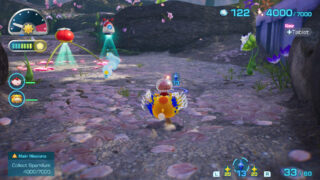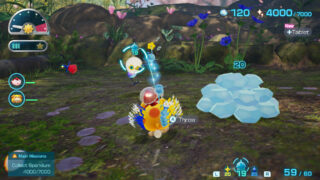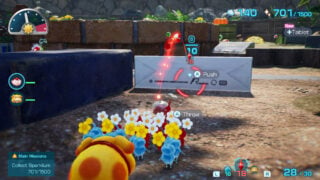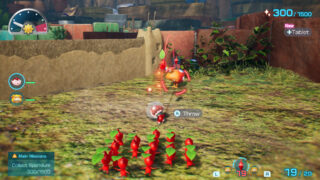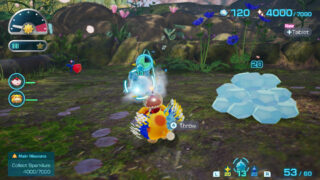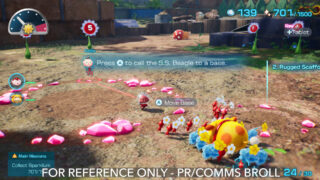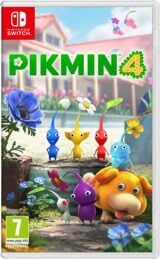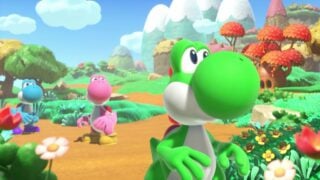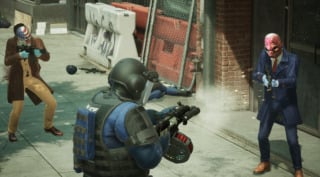Pikmin 4 evolves the series’ gameplay in subtle, yet meaningful ways
Nintendo promises a more chilled experience, but challenge still lies beneath the surface

It’s been almost exactly a decade since the last Pikmin title was released for Wii U. And with creator Shigeru Miyamoto claiming in 2015 that the next instalment was “very close to completion”, many fans have been wondering what exactly has been holding up the Switch series entry, and what kind of outlandish changes such a dev stretch could justify.
When Pikmin 4 was finally revealed via a short teaser last year showing off a new up-close camera angle, I’ll admit that, as a big fan of previous games, I held some concerns.
Previous Pikmin games offered frequently brutal and demanding strategy gameplay, where every second not spent micromanaging your six different species of alien foot soldiers – and later, other squadmates too – marched you closer to sundown, when everyone left unaccounted for would be mercilessly munched by giant bugs and monsters.
Pikmin 4 Onion Locations
Purple Online location | White Onion location | Ice Onion Location | Rock Onion Location | Pink Onion Location
But when you entered that flow state, where you juggled your tasks at peak efficiency, commanding armies across the battlefield to defeat enemies and harvest the planet, Pikmin offered a satisfying, tactile sensation that has yet to be replicated by any strategy game since.
But there’s no denying it’s not a particularly accessible experience, which is likely why the series has never sold amazingly well. So leading up to Pikmin 4, there was plenty of reason to expect a casual-catering overhaul – especially following the 2017 sidescroller, Hey! Pikmin, and 2021’s mobile game, which did precisely that.
At a recent hands-on event, a Nintendo rep did state that one of its goals with the new game was to create a more accessible and less stressful experience than previous games. Thankfully, the “previous games” it appears to be talking about are the original Pikmin – which famously enveloped its campaign with a strict 30-day time limit – and Pikmin 3, which tripled the workload by adding multiple characters simultaneously.
Pikmin 4 is a game that feels much more like fan-favourite GameCube follow-up Pikmin 2, which took the foundations of the original and built a more carefully considered campaign, with no stressful time limit and the most difficult content fenced off via underground dungeons, allowing players to manage their own experience.
The game starts with Captain Olimar, the hero from the original games, yet again crash-landing on a strange planet, which is the home of the Pikmin, an obedient, plant-like race who love nothing more than lifting heavy objects and fighting giant monsters for alien visitors.
A rescue team is dispatched to rescue Olimar, but of course, they end up crash-landing on the planet too. As a rookie, it’s now up to you to explore the surface, find your missing space crew, as well as the treasure required to repair your ship and solve the mystery of what happened to Olimar.
Right off the bat, Pikmin 4 feels closer to a traditional adventure game than the top-down strategy gameplay of the originals. This time, players get to create their own rookie character from scratch, and there’s even a hub area where any crew members you rescue will appear, allowing players to chat to them or access their various features. For a series where previously players spent a lot of time alone, this feels like a big departure, but a welcome one.
We were pleasantly surprised in our short play session to discover that, despite the closer camera angle (which you can easily zoom back up to birds-eye view, if you choose), it very much feels like a traditional Pikmin game. Instead, Nintendo has dialled down the stress via subtle quality-of-life changes that adjust the pace of the game.
“We were pleasantly surprised in our short play session to discover that, despite the closer camera angle, it very much feels like a traditional Pikmin game.”
Like Pikmin 2, the Switch game also separates its most stressful challenges from the core exploration and treasure hunting on the surface. Special underground entrances are located around the game’s opening garden area, and they’re split into different levels containing treasure, puzzles and tough enemies.
While day cycles are still present, and around 15 minutes long, players can now rewind time via the pause menu, should they make a mistake. In the more difficult underground sections, time will even slow down to around a sixth of its average speed, meaning players can take their time completing challenges without fear of the dreaded sunset alarm going off mid-boss battle.
Controls have also been quietly simplified, with aiming auto-targeting to enemies and certain functions, such as the ability to disband your squad, now placed under a quick menu. Players can also move their base to specific points around the map, reducing the stress of having to carry large objects from one end to the other.

The new Pikmin type we were able to try in our demo, the Ice type Pikmin, actually feel like a big accessibility option by themselves. In addition to being able to freeze water to allow other Pikmin to cross, Ice Pikmin can freeze enemies, allowing your army to defeat them much more quickly.
Perhaps the most impactful change to the game’s feel are the alterations to its overall economy systems, the introduction of players’ new canine companion, Oatchi, and hints at underlying RPG-style customisation.
Oatchi will join players on their adventure and can be commanded to smash obstacles, transport heavy objects and carry Pikmin on his back, allowing you to traverse dangerous waterways or jump to small ledges. Perhaps his most impactful abilities, though, incorporate some of the squad gameplay from the previous game: players can use a quick menu to order Oatchi to sniff out treasure or stranded crewmates, and you can also order him to parts of the environment using your mini-map.
“Players can switch and command Oatchi directly at any time, allowing you to perform tasks such as activating a switch, while at the same time, your character progresses via another route with Pikmin in tow.”
Players can switch and command Oatchi directly at any time, allowing you to perform tasks such as activating a switch, while at the same time, your character progresses via another route with Pikmin in tow. So if you want, you can use Oatchi just like a super-strong Pikmin, but it feels like he could be much more useful when treated as a squadmate.
We weren’t able to upgrade Oatchi’s abilities in our early demo, but it appears that the full game will feature a fairly extensive suite of upgrades, with players able to make him stronger, faster or give him entirely new abilities. If executed properly, this could represent quite a significant step forward for the series.
In terms of resources, collecting pellets and taking them to your Onion will again grow more Pikmin, but at the start of the game, you’re now limited to just 20 who can be out on the field simultaneously. In order to increase this, you’ll need to find a new item called Flarlic Bulbs, which will increase the number of Pikmin you can take out by 10.

The giant Treasure you find – which comes in the form of fruits, toys, household items or even Nintendo consoles – also plays a different role. For each piece you collect, you’ll earn fuel for your ship, which eventually will allow you to unlock and reach different areas.
In addition, Pikmin 4 introduces Raw Materials. In previous games, players had to find specific pieces in the world to repair bridges or similar obstacles to progress in the environment. Now, you’ll collect and store Raw Materials during the game as a type of currency, which can eventually be used to purchase new gear or items from the hub world. So at some point, you’ll likely have to decide between building a new climbing wall to reach that just-out-of-touch treasure, or unlocking a new ability.
Pikmin 4 evolves the series’ gameplay in a lot of subtle but meaningful ways then, and that’s before we’re able to try out the new night missions – which introduce ‘glow’ type Pikmin – and the 2-player ‘Dandori’ challenges. You’ll get to try out the game yourself when a demo hits the Nintendo Switch eShop this Wednesday, June 28.

